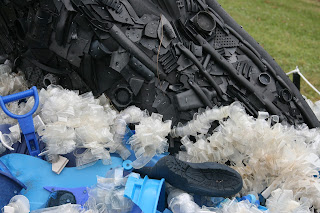I do not have a green thumb.
I managed
to kill an air plant - an air plant. They survive and thrive without
roots.
 |
| Air plant growing upside down in the test of a sea urchin |
In addition to simply requiring water to survive, many individuals find themselves actually addicted to water - the oceans in particular and all activities involved with it. These people also collect countless books and other media on the subject. So, from serious documentaries to children's books... here are critiques to help you find materials and places that will satisfy your cravings!
 |
| Air plant growing upside down in the test of a sea urchin |

 This pair
of sculptures showcases the research done by the artist, making a point of
differentiating the Pacific humpback from the Atlantic whales. In reality this
species has benefitted greatly from conservation efforts over the years, but
personally I cannot help but attribute some of the interest and support in
humpbacks back to Star Trek IV and
the plight of “Gracie” and “George” – mostly because that movie inspired me, an
8-yr old land-locked kid living in the Midwest – to learn and appreciate marine
life for the first time.
This pair
of sculptures showcases the research done by the artist, making a point of
differentiating the Pacific humpback from the Atlantic whales. In reality this
species has benefitted greatly from conservation efforts over the years, but
personally I cannot help but attribute some of the interest and support in
humpbacks back to Star Trek IV and
the plight of “Gracie” and “George” – mostly because that movie inspired me, an
8-yr old land-locked kid living in the Midwest – to learn and appreciate marine
life for the first time. Musical
Seaweed is meant to be an interactive exhibit, but during my time instead the
sky was filled with the roar of planes landing at the airport nearby. It was
the first time I truly noticed the noise, but am reminded how creating
beautiful spaces in areas that many people would not wish to live is
exceptional strategic planning. The areas in and around airports are great for
natural areas and in this case, an amazing garden.
Musical
Seaweed is meant to be an interactive exhibit, but during my time instead the
sky was filled with the roar of planes landing at the airport nearby. It was
the first time I truly noticed the noise, but am reminded how creating
beautiful spaces in areas that many people would not wish to live is
exceptional strategic planning. The areas in and around airports are great for
natural areas and in this case, an amazing garden.
2 comments:
Wow, this is amazing! I SO wish I'd read it while I was in FL last week, as this is something I would have loved to have seen. That said, I hope to be back in June, and maybe I'll get there before it closes. Wonderfully informative piece, with great photos! Thanks for sharing this super exhibit!
Thank you so much, Dawn! I'm sure you will love it when you come to visit. The exhibits are truly larger than life.
Post a Comment